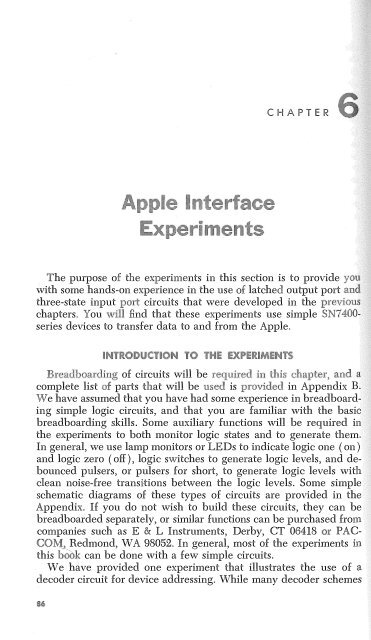Create successful ePaper yourself
Turn your PDF publications into a flip-book with our unique Google optimized e-Paper software.
CHAPTER<br />
The purpose of the experiments in this section is to provide<br />
with some hands-on experience in the use of latched oui:put port and<br />
three-state input circuits that were developed in the<br />
chapters. You find that these experiments use simple<br />
series devices to transfer data to and from the Apple.<br />
of circuits will be<br />
complete list parts that will be is in Appendix B.<br />
·we have assumed that you have had some experience in breadboarding<br />
simple logic circuits, and that you are familiar with the basic<br />
breadboarding skills. Some auxiliary fonctions will be required in<br />
the experiments to both monitor logic states and to generate them.<br />
In general, we use lamp monitors or LEDs to indicate logic one (on)<br />
and logic zero (off), logic svvitches to generate logic levels, and debounced<br />
pu.lsers, or pulsers for short, to generate logic levels with<br />
dean noise-free transitions between the logic levels. Some simple<br />
schematic diagrams of these types of circuits are provided in the<br />
Appendix. If you do not wish to build these circuits, they can be<br />
breadboarded separately, or similar functions can be purchased from<br />
companies such as E & L Instruments, Derby, CT 06418 or PAC<br />
CON[, Redmond, WA 98052. In general, most of the experiments iJ1<br />
this book can be done with a few simple circuits.<br />
We have provided one experiment that illustrates the use of a<br />
decoder circuit for device addressing. While many decoder schemes

















